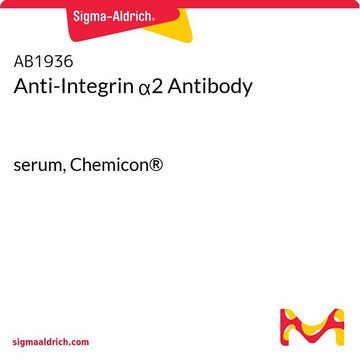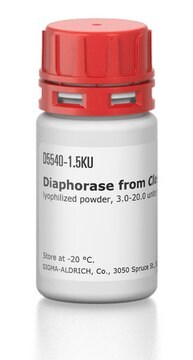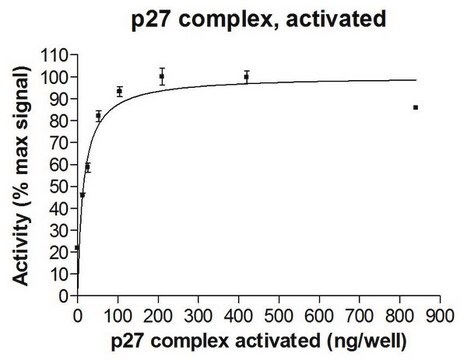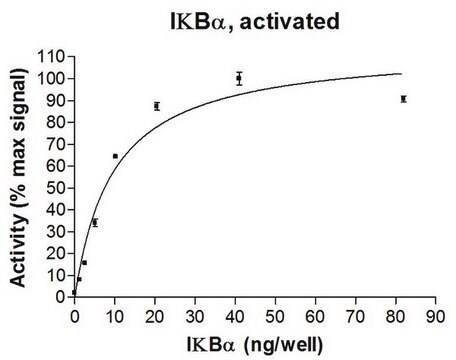MAB1952Z
Anti-Integrin α3 Antibody, clone P1B5, azide free
clone P1B5, Chemicon®, from mouse
Synonym(s):
CD49c, MAB1952
Sign Into View Organizational & Contract Pricing
Select a Size
All Photos(2)
Select a Size
Change View
About This Item
UNSPSC Code:
12352203
eCl@ss:
32160702
NACRES:
NA.41
Recommended Products
biological source
mouse
Quality Level
antibody form
purified immunoglobulin
antibody product type
primary antibodies
clone
P1B5, monoclonal
species reactivity
human
manufacturer/tradename
Chemicon®
technique(s)
immunocytochemistry: suitable
immunohistochemistry: suitable (paraffin)
isotype
IgG1
NCBI accession no.
General description
Integrins are a family of dimeric, transmembrane proteins that mediate cell-cell and extracellular matrix adhesion. Signals transduced by integrins play a role in many biological processes, including cell growth, differentiation, migration and apoptosis. The integrin family is composed of at least 15 alpha and 8 beta subunits that may form over twenty different alpha-beta non-covalently bound dimeric combinations on the cell surface. The alpha subunits all have some homology to each other, as do the beta subunits. Both of the subunits contribute to the binding of the ligand. Integrin alpha subunits contain seven weak sequence repeats in the N-terminal region, which may be important in ligand binding, and have been predicted to fold cooperatively into a single beta-propeller domain with seven beta-sheets. The alpha-3 subunit (CD49c) is highly concentrated in epithelial cells where it strongly adheres to Laminin-5 and Laminin-5 induced rapid adhesion can be blocked by antibodies against the alpha-3 integrin subunit. The alpha-3 subunit exists in two different splice variants, denoted as "A" and "B". The only difference that results from this differential splicing is a total change in the cytoplasmic domain, while the extracellular domain stays the same. Knock-out mice lacking this subunit show prenatal lethality and abnormalities in the kidneys.
Specificity
Reacts with Human alpha3 integrin.
Application
Anti-Integrin α3 Antibody, clone P1B5, azide free detects level of Integrin α3 & has been published & validated for use in IC, IH(P).
Research Category
Cell Structure
Cell Structure
Research Sub Category
Integrins
Integrins
Suitable for use in attachment inhibition assays using fibroblasts, most epithelial cells, activated lymphocytes on laminin, collagen and fibronectin.
Immunohistochemistry on human tonsil
fresh frozen tissue
paraffin embedded tissue; protease digestion required:
Optimal working dilutions must be determined by end user.
Immunohistochemistry on human tonsil
fresh frozen tissue
paraffin embedded tissue; protease digestion required:
Optimal working dilutions must be determined by end user.
Physical form
Format: Purified
Protein A Purified mouse immunoglobulin in 20 mM sodium phosphate, 250 mM NaCl, pH. 7.6, with no preservatives.
Protein A purified
Storage and Stability
Maintain at 2–8°C in undiluted aliquots for up to 6 months after date of receipt.
During shipment, small volumes of product will occasionally become entrapped in the seal of the product vial. For products with volumes of 200μL or less, we recommend gently tapping the vial on a hard surface or briefly centrifuging the vial in a tabletop centrifuge to dislodge any liquid in the container′s cap.
During shipment, small volumes of product will occasionally become entrapped in the seal of the product vial. For products with volumes of 200μL or less, we recommend gently tapping the vial on a hard surface or briefly centrifuging the vial in a tabletop centrifuge to dislodge any liquid in the container′s cap.
Analysis Note
Control
Human foetal foreskin fibroblasts (HFFF), neuroblastomas
Human foetal foreskin fibroblasts (HFFF), neuroblastomas
Other Notes
Concentration: Please refer to the Certificate of Analysis for the lot-specific concentration.
Legal Information
CHEMICON is a registered trademark of Merck KGaA, Darmstadt, Germany
Disclaimer
Unless otherwise stated in our catalog or other company documentation accompanying the product(s), our products are intended for research use only and are not to be used for any other purpose, which includes but is not limited to, unauthorized commercial uses, in vitro diagnostic uses, ex vivo or in vivo therapeutic uses or any type of consumption or application to humans or animals.
Not finding the right product?
Try our Product Selector Tool.
recommended
Product No.
Description
Pricing
Storage Class Code
12 - Non Combustible Liquids
WGK
WGK 2
Flash Point(F)
Not applicable
Flash Point(C)
Not applicable
Certificates of Analysis (COA)
Search for Certificates of Analysis (COA) by entering the products Lot/Batch Number. Lot and Batch Numbers can be found on a product’s label following the words ‘Lot’ or ‘Batch’.
Already Own This Product?
Find documentation for the products that you have recently purchased in the Document Library.
The role of fibrin E on the modulation of endothelial progenitors adhesion, differentiation and angiogenic growth factor production and the promotion of wound healing.
Francisco Caiado,Tania Carvalho,Fernanda Silva,Catarina Castro,Nuno Clode,Julian F Dye,Sergio Dias
Biomaterials null
E A Kramár et al.
Neuroscience, 110(1), 29-39 (2002-03-08)
Several lines of evidence suggest that integrin receptors play a pivotal role in consolidation of long-term potentiation (LTP), but which of the many integrin dimers are involved remains to be discovered. The present study used an LTP reversal paradigm to
Reelin provides an inhibitory signal in the migration of gonadotropin-releasing hormone neurons.
Cariboni, A; Rakic, S; Liapi, A; Maggi, R; Goffinet, A; Parnavelas, JG
Development null
Identification of multiple cell adhesion receptors for collagen and fibronectin in human fibrosarcoma cells possessing unique alpha and common beta subunits.
Wayner, E A and Carter, W G
The Journal of cell biology, 105, 1873-1884 (1987)
Feng-Yi Ke et al.
Cancer science, 111(10), 3478-3492 (2020-07-11)
Ovarian cancer has a high recurrence rate after platinum-based chemotherapy. To improve the treatment of ovarian cancer and identify ovarian cancer-specific antibodies, we immunized mice with the human ovarian carcinoma cell line, SKOV-3, and generated hybridoma clones. Several rounds of
Our team of scientists has experience in all areas of research including Life Science, Material Science, Chemical Synthesis, Chromatography, Analytical and many others.
Contact Technical Service








